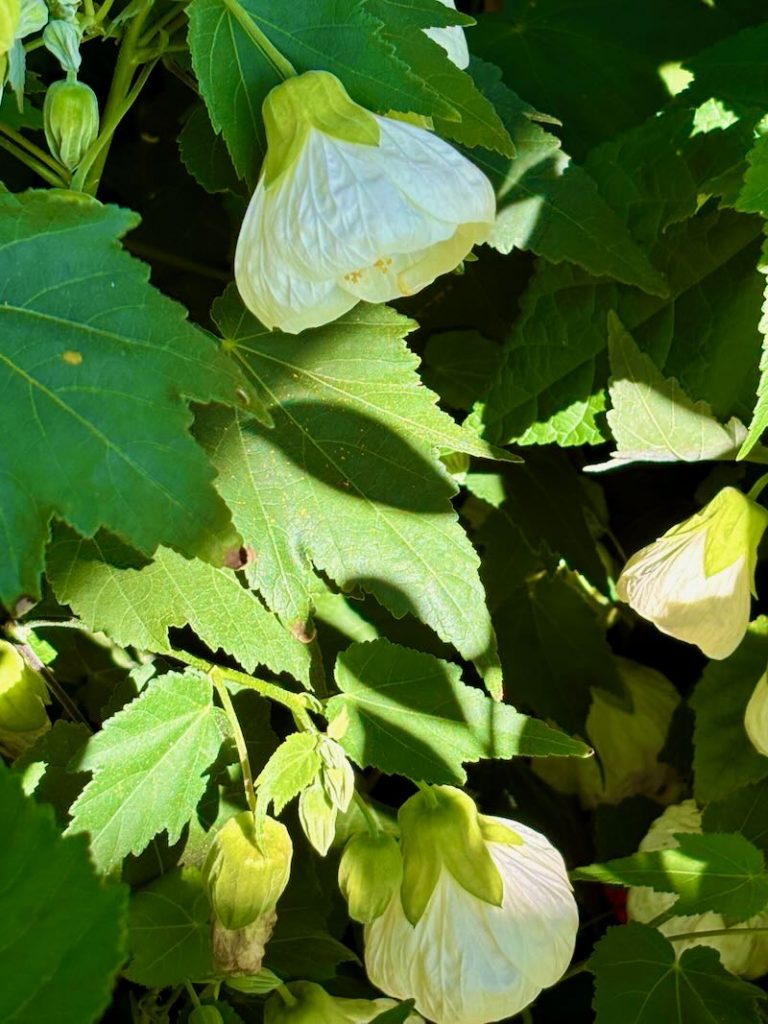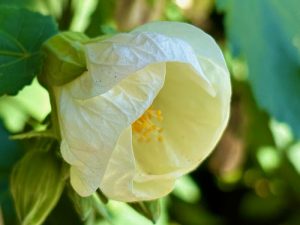Abutilon hybridum ‘Canopus’: A Lantern of White Light in the Garden
Few plants bring such a calm and luminous elegance to the garden as Abutilon hybridum ‘Canopus‘. Known commonly as the white flowering maple, this shrub isn’t a maple at all, but rather a member of the mallow family (Malvaceae), sharing kinship with hibiscus, hollyhock, and lavatera. Its name nods to its lantern-like blooms, which dangle gracefully like tiny bells in shades of pure white, set against soft, maple-shaped green foliage.
In mild climates, Abutilon hybridum ‘Canopus’ performs as a broadleaf evergreen shrub, offering nearly year-round interest with its cascading flowers and lush texture. It’s fast-growing but never unruly, typically reaching 1.2–1.5 meters (4–5 feet) in height and spreading 0.9–1.2 meters (3–4 feet) wide. This makes it ideal for containers, borders, or as a specimen that softens hardscapes with its arching stems and light-catching blooms.
Gardeners appreciate this variety for more than just its looks—it also attracts hummingbirds, butterflies, and bees. Its white flowers, which appear from spring well into fall, make it a quiet but striking pollinator magnet.
Growing Abutilon hybridum ‘Canopus’
To get the best out of Abutilon hybridum ‘Canopus’, offer it the right conditions from the start. Though forgiving, it will reward attentive care with even fuller growth and a longer bloom season.
Light
This abutilon thrives in full sun to partial shade. In cooler climates, give it full sun—at least 6 hours daily—for the most abundant flowering. In hotter regions or intense afternoon sun, filtered light or partial shade prevents leaf scorch and helps keep the blooms fresh.
Indoors, place the plant near a south or west-facing window where it will get strong but indirect light. In lower-light conditions, it may grow leggy and flower less.
Soil
Abutilon hybridum ‘Canopus’ does best in well-drained, fertile soils rich in organic matter. Loamy or silty textures are ideal, though it can tolerate clay soils if drainage is good. Slightly acidic to neutral pH (around 6.0–7.0) works well.
When growing in containers, use a high-quality potting mix with peat, compost, and perlite or bark for drainage. A 3-gallon (11.4-liter) or larger container gives the plant room to develop a healthy root system.
Watering
These plants appreciate regular moisture but dislike soggy feet. Water deeply when the top 2.5 cm (1 inch) of soil feels dry. In hot weather or container settings, more frequent watering may be needed. Reduce water in winter, especially for indoor plants.
Be cautious not to let the roots sit in water. Root rot can be a common issue with overwatering or poorly draining soils.
Fertilizing
Feed Abutilon hybridum ‘Canopus’ with a balanced, water-soluble fertilizer every two to four weeks during the growing season (spring through early fall). A 10-10-10 or 20-20-20 NPK formula works well. Avoid heavy fertilization in winter when growth naturally slows.
Temperature and Hardiness
This abutilon is hardy in USDA zones 9a through 10b. It tolerates brief dips to -6.7 °C (20 °F), but consistent cold will damage or kill the top growth. In cooler zones, grow it as a summer annual or overwinter it indoors.
Indoors, keep it at 18–24 °C (65–75 °F) during the day, and don’t let temperatures drop below 10 °C (50 °F) at night.
Humidity
Moderate humidity is ideal, especially for indoor plants. If your home is dry in winter, a nearby pebble tray or occasional misting helps prevent leaf edges from browning.
Pruning and Maintenance
Pruning is key to keeping Abutilon hybridum ‘Canopus’ looking tidy and producing flowers. Pinch back young stems in spring to encourage branching and bushier growth. After the main bloom period or in late winter, prune by up to one-third to shape the plant and remove leggy or weak stems.
Deadheading is usually not necessary, as new flowers constantly replace old ones. However, you can remove spent blooms if you wish to tidy up the plant.
Support weak stems with light staking in windy spots or after heavy pruning. Pinching helps reduce this problem over time.
Propagation
There are two common propagation methods for Abutilon hybridum ‘Canopus’:
- Stem cuttings: In spring or early summer, take 10–15 cm (4–6 inch) softwood cuttings, strip the lower leaves, dip the cut end in rooting hormone, and place in moist potting mix. Rooting typically occurs in 2–4 weeks.
- Seeds: While propagation by seed is possible, note that hybrids like ‘Canopus’ may not grow true to type. Seed-grown plants may differ in flower color or form.
Pests and Problems
This plant is generally low-maintenance, but pests may appear, particularly indoors or in greenhouse settings.
- Aphids and whiteflies can colonize new growth and undersides of leaves.
- Spider mites thrive in dry, dusty conditions.
- Mealybugs and scale may also infest stems and leaf nodes.
Check plants regularly and treat with insecticidal soap, neem oil, or horticultural oil if needed. Maintaining good airflow and avoiding over-fertilization helps reduce infestations.
Garden Uses for Abutilon hybridum ‘Canopus’
The arching, upright form and glowing white flowers of this abutilon make it an exceptional choice for:
- Containers and patios: Use large pots to create a tropical, cottage, or woodland-themed corner.
- Borders and entryways: Plant where its long bloom time adds consistent interest.
- Pollinator gardens: Draw in bees, butterflies, and hummingbirds from spring to fall.
- Indoor conservatories or sunny windows: A bright accent for cool-season rooms.
Its medium texture and elegant habit let it pair well with both bold foliage plants and finer-textured companions like ferns or salvia.
Final Thoughts on Abutilon hybridum ‘Canopus’
Whether you’re looking for a flowering shrub for a mild-climate garden or a standout container plant to brighten your porch or patio, Abutilon hybridum ‘Canopus’ brings a refined, luminous beauty. With simple care and a bit of pruning, it will reward you with graceful blooms and steady growth season after season.



